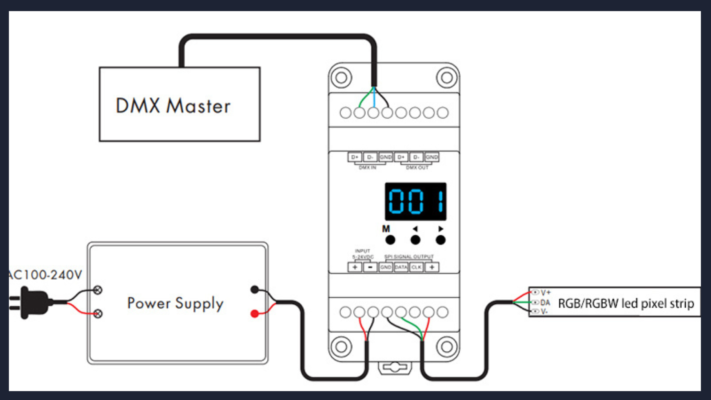All about DMX Lighting Control System in Dubai

Complete Guide to DMX Lighting Control Systems in Dubai
Digital Multiplex, commonly known as DMX Lighting Control System, is a unidirectional lighting control protocol that enables the management of complex lighting sequences from a single source. DMX is not limited to lighting; it includes special effects like fog machines (that can be triggered to emit fog at specific points in performance) and other enhancements (such as strobe lights that can be synchronized with music) to elevate the lighting experience.
Even if you’re new to DMX lighting, optimizing your lighting setup is straightforward. Here, we’ll answer common questions, empowering you to master your DMX lighting system.
What is DMX Lighting?
DMX lighting involves fixtures controlled by one or more channels, which can be operated individually or in groups. When the controller sends out data, it travels in a daisy chain through all the lighting fixtures in sequence rather than controlling each light independently. At the end of this chain, a terminator is used to prevent the signal from bouncing back and causing distortions.
Typically, a DMX setup operates from a controller device, though multiple master controllers can be present in larger lighting systems.
How long has DMX lighting been around?
Despite its advanced capabilities, DMX has been around since 1986. It was developed as a solution to the cumbersome remote-control lighting systems of the time, which required a separate cable for each light fixture. DMX allows a single cable to manage all fixture functions, simplifying the setup process.
How to connect DMX lights
Connecting DMX lights is straightforward. Connect your cables to the DMX controller and then to the DMX IN on your first fixture. Connect to the next fixture from the DMX OUT of that fixture, continuing this pattern with all fixtures set to the same DMX channel model.
DMX lighting wiring diagram

What is a DMX channel?
DMX channels are used to control the actions of your light fixtures. The more variations you want in your setup, the more channels you need. Often referred to as a ‘DMX Universe,’ a DMX system can control up to 512 channels. For example, each colour in an RGB setup requires one channel, so an RGBW setup would need four channels, allowing a DMX Universe (a term used to describe the maximum number of channels a DMX system can control) to control 128 RGBW fixtures (512/4 = 128).
What is a DMX LED fixture?
DMX LED fixtures, a vital component of a DMX lighting system, are light fixtures that can be grouped or programmed independently through DMX channels. They are energy-efficient, versatile, and offer a range of lighting effects, making them ideal for various applications.
How and when is DMX lighting used?
DMX lighting is a versatile tool that is not limited to large installations. It’s equally effective for smaller applications, offering the freedom to adjust the colour and brightness of fixtures with ease. Let your creativity shine with DMX lighting!
Do I need a DMX controller for DMX lighting?
A DMX controller, a vital component of a DMX lighting system, is essential for running such a system. It’s a device that sends digital signals to the fixtures, controlling their actions. While connecting DMX fixtures without a controller is possible, they must operate in a sound-active or automatic mode.
Our DMX controllers offer:
- Four zones
- Programmable options for four playbacks
- Pre-programmed looks, including chasing and single-colour
- Dimming
- Speed control and colour scroll
- And more!
Pros and cons of DMX lighting
Advantages:
- Efficiency: DMX fixtures operate on low voltage, making them energy-efficient.
- Ease of use: DMX systems communicate through digital signals and can be controlled by a single controller.
- Versatility: Mix and match different fixture brands and models without needing to replace existing equipment.
- Customization: DMX allows for highly customizable lighting setups, syncing with music or moving spotlights with precision.
Disadvantages:
- Cable requirements: DMX systems need low-capacitance cables so that standard mic cables won’t work. Signal integrity is a crucial aspect of DMX systems. Each fixture can degrade the signal, especially in large setups or when using long cables. It’s best to keep cable lengths under 1,000 feet to maintain a strong signal. A data splitter amplifies and distributes the DMX signal and is recommended for longer runs to ensure signal integrity.
- Load management: Avoid using more than 32 loads per network segment to ensure optimal performance; use a data splitter if additional loads are required.
- Setup time: A DMX system can be time-consuming, so plan accordingly for custom light show preparations.
- Terminator necessity: A terminator, a device that absorbs the DMX signal at the end of the chain, is crucial in preventing signal bounce (a phenomenon where the signal reflects and interferes with the primary signal) and ensuring the smooth operation of the DMX lighting system.







